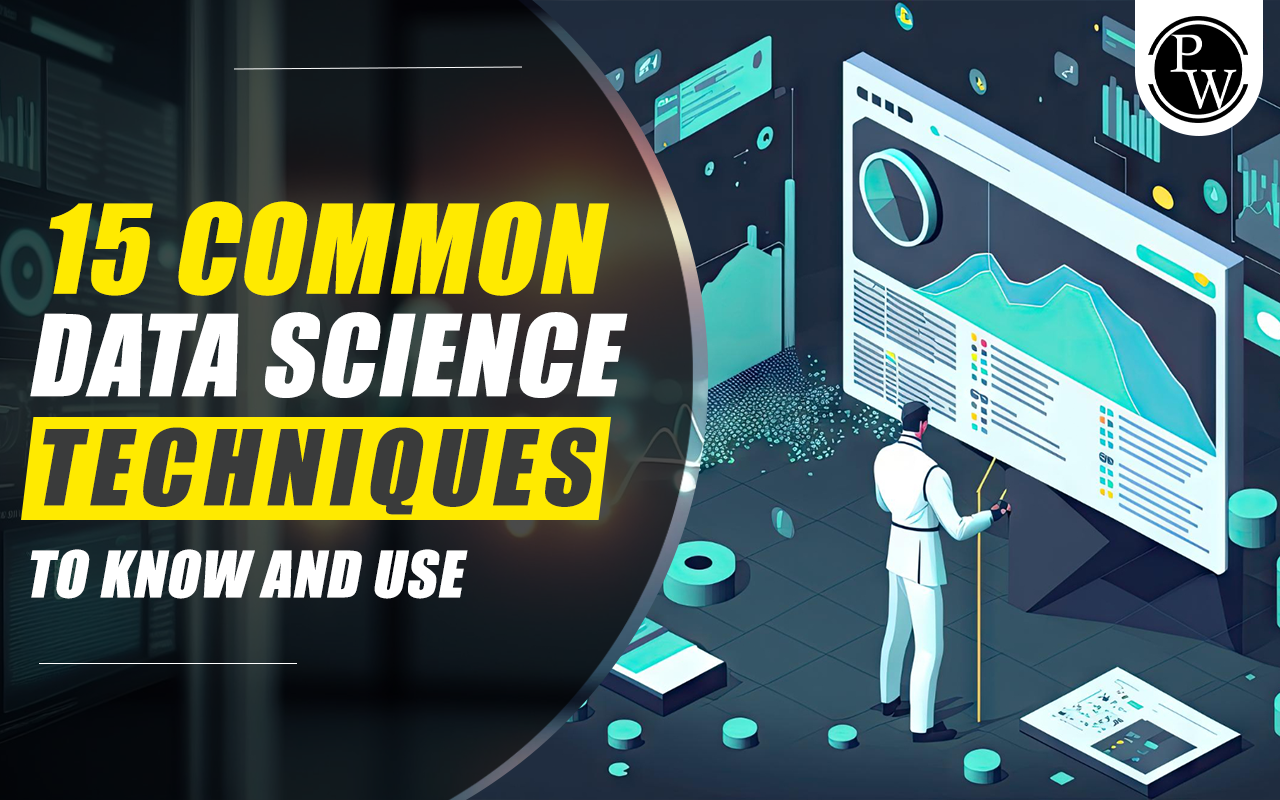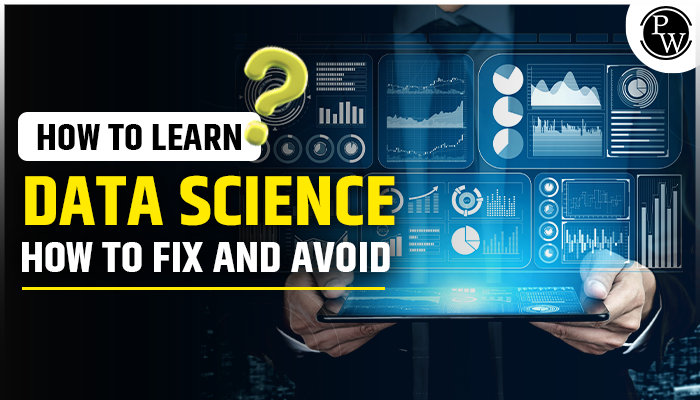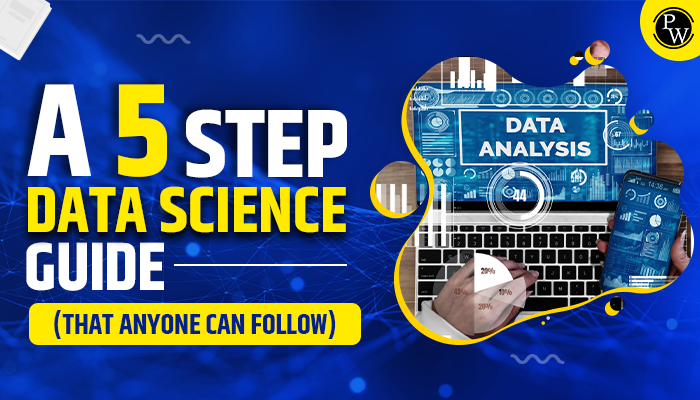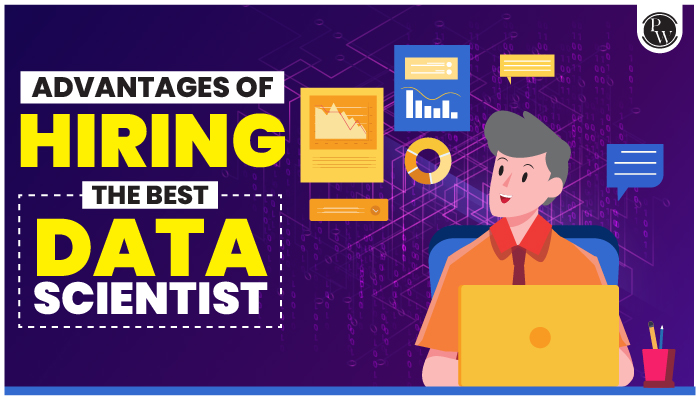Data Science Techniques: Data exploration is a treasure trove of hidden insights. It speaks more than just the visible entities. In a world awash with information, deciphering patterns and making informed decisions is a coveted skill. From data collection to advanced techniques like neural networks, this adventure promises revelations. In this blog, we’ll talk about some common data science techniques, examples, applications, and much more!
If you want to make a successful and decorated career as a data scientist, a Full-Stack Data Science course is ideal for you!
10+ Common Data Science Techniques to Know and Use
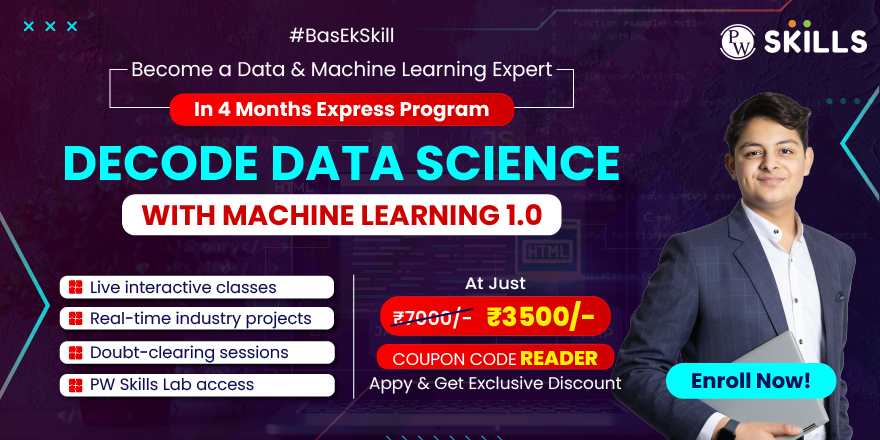
1. Descriptive Statistics
Descriptive statistics lay the groundwork for any data analysis by providing a comprehensive summary of key features within a dataset. Mean, median, mode, range, and standard deviation show how data is centred and spread. Knowing these stats is crucial for making smart decisions based on data patterns.
Descriptive statistics, through graphical representations and summary metrics, allow data scientists to communicate complex information in a concise and comprehensible manner. Real-world applications range from summarising survey responses to assessing the distribution of product sales, making descriptive statistics an essential first step in any data analysis endeavour.
How to Use
Begin by collecting and cleaning data, ensuring its accuracy. Calculate basic metrics like mean, median, mode, range, and standard deviation. Visualise data using histograms, box plots, or scatter plots for better understanding. Analyse results to identify trends, central tendencies, and outliers.
2. Inferential Statistics
Inferential statistics takes data analysis a step further by drawing conclusions about a population based on a sample. Hypothesis testing and confidence intervals are fundamental components of inferential statistics, guiding researchers and analysts in making inferences about the broader context of the data. The application of inferential statistics extends to diverse fields, including healthcare, finance, and social sciences.
Hypothesis testing means creating and testing ideas about a population measure, guiding decisions in uncertain situations. Meanwhile, confidence intervals provide a likely range for a population measure. These methods are priceless for decision-makers who want to apply sample insights to a bigger population.
How to Use
Formulate hypotheses, state significance levels, and collect data for inferential tests. Use statistical software for tests like t-test or chi-square. Analyse results, comparing p-values to the significance level, and draw conclusions about the population.
Read More: Descriptive vs Inferential Statstics
3. Regression Analysis
Regression analysis helps in predictive modelling by revealing connections between variables for accurate predictions. Linear regression handles continuous outcomes, while logistic regression deals with binary results, offering insights into factors impacting the dependent variable.
Linear regression shows how independent and dependent variables relate through a fitted linear equation. Logistic regression, vital for predicting binary outcomes like customer purchases, aids data scientists in revealing patterns for informed decisions.
How to Use
Prepare and clean the dataset, select variables, and train a regression model. Evaluate its performance using metrics like MSE or R-squared. Apply the trained model to predict outcomes in new data.
4. Classification Algorithms
In machine learning, classification algorithms categorise data into groups. Decision Trees, Random Forest, and Naive Bayes are potent tools for this task, applying to various real-world situations due to their versatility.
Decision Trees, for instance, break down a dataset into smaller subsets, making decisions at each branch based on the input features. Random Forest, an ensemble learning technique, aggregates the predictions of multiple decision trees to improve accuracy and robustness. Naive Bayes, a probabilistic algorithm, proves beneficial in natural language processing and spam detection. Mastery of classification algorithms is essential for image recognition, sentiment analysis, and fraud detection.
How to Use
Clean and preprocess data, select relevant features, and split the dataset. Choose a classification algorithm (e.g., Decision Trees) and train the model. Evaluate its performance using accuracy, precision, and recall, and make predictions on new data.
5. Clustering
Clustering techniques play a pivotal role in unsupervised learning, where the goal is to identify inherent patterns and group similar data points together. K-means and hierarchical clustering are widely used methods, each with its strengths and applications. Clustering is particularly beneficial in scenarios where the underlying structure of the data is not explicitly known.
K-means clustering sorts data into clusters based on similarity. It’s handy for things like customer grouping and pattern spotting. Hierarchical clustering, however, arranges data into a tree-like structure, revealing links between clusters. Clustering methods, from market segmentation to spotting oddities, are vital for finding patterns in messy data.
How to Use
Normalise data, choose a clustering algorithm, and determine the number of clusters. Assign data points to clusters and visualise results with scatter plots. Interpret the meaning of each cluster in the context of the problem.
6. Dimensionality Reduction
As datasets grow in size and complexity, dimensionality reduction becomes essential for enhancing computational efficiency and improving model performance. Principal Component Analysis (PCA) and t-Distributed Stochastic Neighbour Embedding (t-SNE) are powerful techniques for reducing the number of features while retaining critical information.
Principal Component Analysis finds key parts of data that capture the most variance. By keeping some of these parts, data experts can reduce dimensions without losing much info. On the flip side, t-Distributed Stochastic Neighbour Embedding is great for showing high-dimensional data in simpler spaces. These methods are key for dealing with too many dimensions, improving computer speed, and stopping machine learning models from fitting too closely.
How to Use
Standardise variables, choose a reduction technique (e.g., PCA), and apply it. Evaluate explained variance and integrate reduced data into machine learning models for efficiency.
7. Time Series Analysis
Time series analysis is paramount when dealing with data points collected sequentially over time. This technique is crucial for tasks such as predicting stock prices, analysing weather patterns, and understanding user behaviour trends. Time series analysis involves understanding and modelling the temporal dependencies within the data, allowing for accurate predictions and informed decision-making.
Moving averages, a common time series analysis technique, smooth out fluctuations in data by averaging values over a specified window. Autoregression models, on the other hand, capture the relationship between an observation and several lagged observations. These techniques are essential for extracting meaningful insights from time-dependent data, facilitating trend analysis, and improving forecasting accuracy.
How to Use
Prepare time-stamped data, visualise time series, and select appropriate models (e.g., ARIMA). Train, validate, and tune parameters. Make forecasts for future time points and evaluate predictions using metrics like MAE or RMSE.
8. Natural Language Processing (NLP)
NLP is a specific area in data science dealing with computer-human language interaction. Techniques like tokenization, stemming, and sentiment analysis help extract insights from text, enabling various applications.
Tokenization involves breaking down a text into individual words or phrases, facilitating subsequent analysis. Stemming aims to reduce words to their root form, simplifying the analysis of word frequency and patterns. Sentiment analysis, another crucial NLP technique, determines the emotional tone of a piece of text, making it invaluable for understanding customer feedback, social media sentiment, and more. NLP is at the forefront of language-related tasks, influencing applications such as chatbots, language translation, and content categorization.
How to Use
Clean and preprocess text data, tokenize, and use stemming or lemmatization. Extract features using techniques like TF-IDF. Choose an NLP algorithm, train and evaluate it on labelled data, and extract insights from textual data.
9. Neural Networks
Deep learning, based on the intricate design of the human brain, relies on neural networks. Feedforward, recurrent, and convolutional networks excel in tasks such as image recognition, speech processing, and language translation. Understanding neural networks is fundamental for delving into the world of deep learning, where hierarchical layers of interconnected nodes process and transform input data.
Feedforward neural networks, the simplest form of neural networks, consist of input, hidden, and output layers, with information flowing in one direction. Recurrent neural networks introduce loops to allow information persistence, making them suitable for sequential data. Optimised for image tasks, convolutional neural networks employ convolutional layers to spot patterns. Neural networks lead AI progress, advancing computer vision, language understanding, and intricate pattern recognition.
How to Use
Clean and preprocess text data, tokenize, and use stemming or lemmatization. Extract features using techniques like TF-IDF. Choose an NLP algorithm, train and evaluate it on labelled data, and extract insights from textual data.
10. Ensemble Learning
Ensemble learning combines the predictions of multiple models to create a more robust and accurate predictive model. Techniques such as bagging, boosting, and stacking leverage the diversity of individual models to mitigate overfitting and enhance predictive performance. Ensemble learning has proven effective in various applications, from healthcare diagnostics to financial forecasting.
Bagging, short for bootstrap aggregating, involves training multiple models on different subsets of the training data and aggregating their predictions. Boosting, on the other hand, focuses on sequentially training models to correct the errors of the previous ones. Stacking, a more advanced ensemble technique, combines the predictions of multiple models using another model. Ensemble learning capitalises on the strengths of different algorithms, enhancing the overall predictive power of the model and contributing to more accurate and stable predictions.
How to Use
Prepare data, choose an ensemble technique, and select diverse base models. Train base models, combine predictions (average for bagging, weight for boosting, or use another model for stacking), and evaluate ensemble model performance. Adjust parameters for optimization.
11. Cross-Validation
Crucial in evaluating ML model performance, cross-validation involves splitting the dataset into training and testing subsets repeatedly. This aids in gauging the model’s generalizability and reliability. It’s key to prevent overfitting, ensuring the model excels with new data, and provides a precise performance estimate.
Common cross-validation techniques include k-fold cross-validation, where the dataset is divided into k subsets, and the model is trained and tested k times. Leave-One-Out cross-validation involves training the model on all but one data point and testing on the excluded point, repeating this process for each data point. Cross-validation is a critical tool for model selection, hyperparameter tuning, and assessing the generalizability of machine learning models.
How to Use
Prepare data, choose a cross-validation technique, split data, train, and validate for each fold. Evaluate performance metrics for tuning and improving model performance.
12. Data Preprocessing
Effective data preprocessing is the foundation for accurate and reliable analyses. This phase involves cleaning raw data, handling missing values, and transforming variables to create a suitable input for machine learning models. Techniques such as normalisation, encoding, and feature scaling are essential for ensuring that the data is in a format conducive to accurate model training.
Handling missing data involves strategies such as imputation or removal of missing values, depending on the context and impact on the analysis. Normalisation and feature scaling standardise the range of variables, preventing certain features from dominating the modelling process. Transforming non-numeric data into numbers, encoding categorical variables allows machine learning algorithms to process information efficiently. Data preprocessing is vital in the data science pipeline, ensuring clean, relevant data ready for analysis.
How to Use
Clean data by handling missing values, normalise numerical features, encode categorical variables, perform feature engineering, and split the dataset into training and testing sets for model evaluation.
13. A/B Testing
A/B testing, also known as split testing, is a powerful technique for optimising decisions by comparing two versions of a variable to determine which performs better. Whether it’s testing different versions of a website, marketing emails, or product features, A/B testing provides a systematic approach to decision-making and continuous improvement based on real-time feedback.
The A/B testing process typically involves selecting a metric to measure, randomly assigning users to different groups, implementing the changes in one group (A) while maintaining the status quo in the other group (B), and analysing the performance based on the chosen metric. By comparing the outcomes of the two groups, data scientists can identify which version leads to better results, informing decisions and strategies with empirical evidence.
How to Use
Define objectives, identify variables, randomly assign groups, implement changes, collect data, analyse results statistically, and draw conclusions about implementing or rejecting changes.
14. Data Visualization
Data visualisation is the art of representing data visually, making complex information more accessible and understandable. Matplotlib, seaborn, and Tableau aid data scientists in crafting impactful visualisations for effective communication of insights. Visualisation is vital for spotting patterns, trends, and outliers, guiding informed decision-making and broad audience understanding.
Matplotlib and seaborn, Python favourites, provide diverse charts for visualising data distributions and relationships. Meanwhile, Tableau, a robust tool, enables dynamic visualisations for in-depth data exploration. Visualisation serves as a crucial link between raw data and actionable insights in the data science journey.
How to Use
Identify the audience, choose appropriate visualisation tools, select the right type of visualisation, highlight key findings, label axes and legends for clarity, iterate based on feedback, and embed visualisations into reports or presentations for effective communication.
Data Science Techniques Examples
Descriptive Statistics
Mean, Median, Mode
Descriptive statistics provide a summary of the main aspects of a dataset. The mean, median, and mode are measures of central tendency that help understand the typical value in a set of data. The mean is the average, the median is the middle value, and the mode is the most frequently occurring value. For instance, in a dataset of sales figures, calculating the mean provides an overview of the average sales, while the median offers insight into the middle point, mitigating the impact of outliers.
Variance and Standard Deviation
Variance and standard deviation quantify the spread or dispersion of data. A low standard deviation indicates that the data points tend to be close to the mean, while a high standard deviation implies that the values are more spread out. These measures are invaluable in understanding the variability within a dataset, critical for making predictions and drawing conclusions.
Regression Analysis
Simple Linear Regression
Regression analysis models the relationship between a dependent variable and one or more independent variables. Simple linear regression involves predicting a dependent variable using a single independent variable. For instance, in a real estate context, one might use simple linear regression to predict house prices based on the square footage of the property.
Multiple Linear Regression
Expanding on simple linear regression, multiple linear regression incorporates multiple independent variables to predict a dependent variable. In the context of, say, predicting a student’s GPA, factors like study hours, extracurricular activities, and attendance can be considered simultaneously to enhance the accuracy of predictions.
Classification Techniques
Logistic Regression
Despite its name, logistic regression is a classification algorithm commonly used for binary classification problems. It predicts the probability of an instance belonging to a particular class. For instance, it could be employed to predict whether an email is spam or not based on various features.
Decision Trees and Random Forests
Decision trees are a visual representation of decision-making processes. In a data science context, decision trees can be used for both classification and regression tasks. Random Forests, an ensemble learning method, improve on decision trees by aggregating multiple trees, enhancing predictive accuracy and reducing overfitting.
Clustering Techniques
K-means Clustering
Clustering involves grouping similar data points together based on certain features. K-means clustering is a popular method where ‘k’ represents the number of clusters. This technique is widely used for customer segmentation, grouping similar customers based on purchasing behaviour, for example.
Hierarchical Clustering
Hierarchical clustering builds a tree of clusters. It is useful when the number of clusters is not known beforehand. This technique can be applied in genomics, where it’s used to analyse genetic similarity among different species.
Data Science Techniques Applications
Predictive Analytics
Forecasting Future Trends
Predictive analytics leverages historical data and statistical algorithms to predict future trends. For businesses, this can mean forecasting sales, demand for products, or even stock prices. Time series analysis, a key component of predictive analytics, enables the identification of patterns in chronological data, aiding in making informed predictions.
Predicting Customer Behaviour
Understanding and predicting customer behaviour is a pivotal application of data science techniques. Businesses can employ predictive modelling to anticipate customer preferences, tailor marketing strategies, and enhance customer satisfaction. This is especially pertinent in the e-commerce sector, where recommendations based on previous purchases and browsing behaviour can significantly impact sales.
Also Read: Predictive Analysis: Predicting the Future with Data
Natural Language Processing (NLP)
Text Mining and Sentiment Analysis
Natural Language Processing (NLP) involves the interaction between computers and human language. Text mining, a subset of NLP, focuses on extracting valuable information and patterns from unstructured text data. Sentiment analysis, for instance, assesses opinions expressed in text, a valuable tool for businesses to gauge customer sentiment towards products or services.
Chatbots and Language Translation
Incorporating NLP, chatbots provide automated responses to user queries, streamlining customer service. Language translation is another NLP application, breaking down language barriers by automatically translating text or speech from one language to another. These applications have transformative effects, not only in business but also in enhancing accessibility on a global scale.
Image Recognition
Object Detection
Image recognition involves teaching computers to interpret and make decisions based on visual data. Object detection, a subset of image recognition, identifies and locates objects within an image. This has widespread applications, from facial recognition for security purposes to identifying defects in manufacturing processes.
Facial Recognition
Facial recognition is a sophisticated application of image recognition with diverse use cases. Beyond security applications, it’s employed in industries such as retail for personalised shopping experiences and in health care for patient identification. However, ethical considerations regarding privacy and consent are paramount when implementing facial recognition technologies.
Must Check: Free Data Science Courses: A Certificate Guide for 2024
Conclusion
In the dynamic realm of data science, from cleaning data to implementing cutting-edge algorithms, the journey unfolds with each step holding the promise of discovery. Robust statistical methods, predictive modelling, and efficient clustering techniques provide insights into the past, present, and future. Time series analysis, natural language processing, and neural networks offer windows into intricate patterns and complexities. Ensemble learning amplifies the symphony of algorithms, while A/B testing guides decisions with empirical precision. Data visualisation becomes the storyteller, translating complexity into clarity. In this evolving landscape, the art and science of data analysis converge, revealing stories waiting to be told.
Don’t miss out on this opportunity to become a highly sought-after data scientist. Our Full Stack Data Science Pro course equips you with the industry-demanded skills and hands-on experience to succeed in this dynamic field. Enrol now and open doors to a rewarding career in data science!
FAQs
Why is it important to iterate on data visualisations based on feedback?
Iteration allows for refinement and improvement of visualisations, ensuring they effectively communicate insights to the intended audience.
Can clustering algorithms handle categorical data?
Some clustering algorithms, like k-modes for example, are designed to handle categorical data, but preprocessing may be required for others.
How does leave-one-out cross-validation differ from k-fold cross-validation?
Leave-one-out cross-validation is a special case of k-fold cross-validation where each fold consists of a single data point, providing a more thorough assessment but at a higher computational cost.
Can you use PCA for feature selection in machine learning?
PCA is primarily used for dimensionality reduction, but it indirectly contributes to feature selection by identifying principal components that capture the most variance in the data.
What role does the learning rate play in training neural networks?
The learning rate determines the size of the steps taken during optimization. Finding an appropriate learning rate is crucial for achieving optimal convergence and avoiding overshooting or slow

